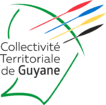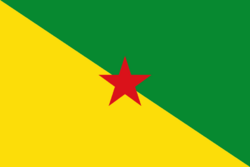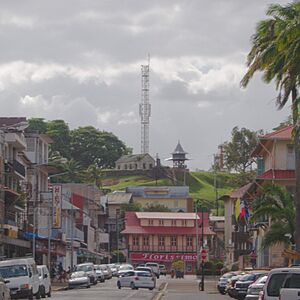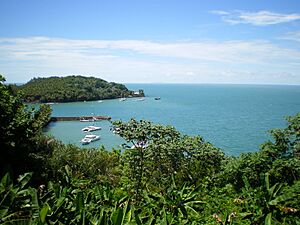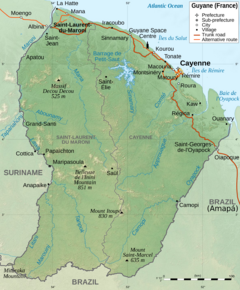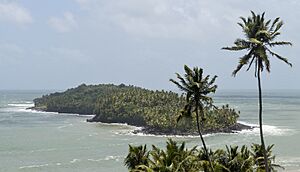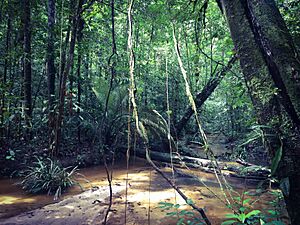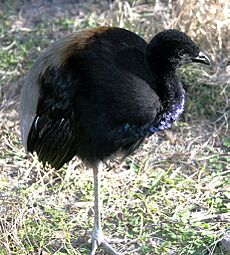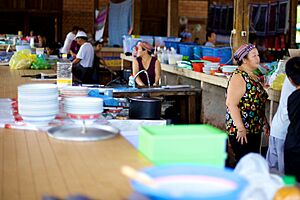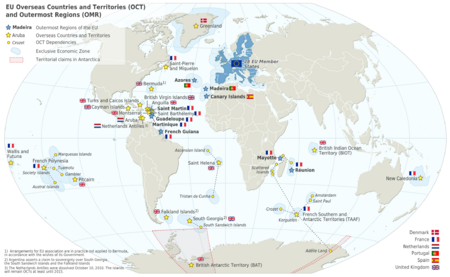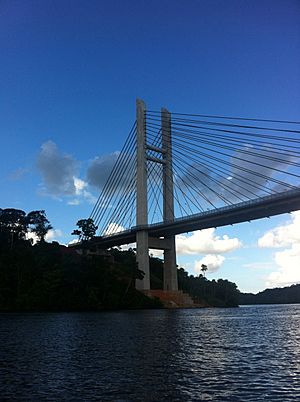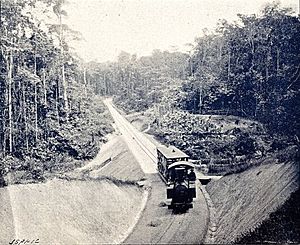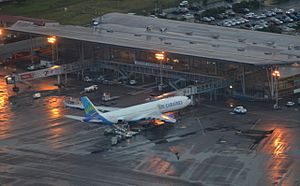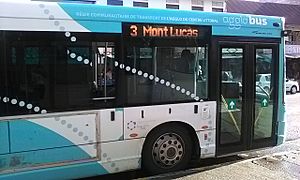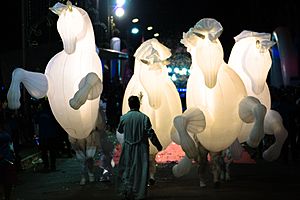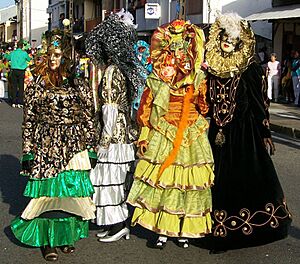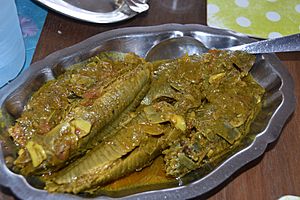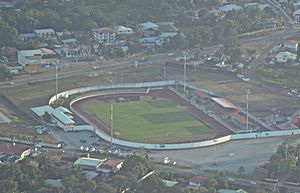French Guiana facts for kids
Quick facts for kids
French Guiana
|
|||
|---|---|---|---|
|
Overseas department, region and single territorial collectivity of France and outermost region of the European Union
|
|||
| Territorial Collectivity of French Guiana Collectivité territoriale de Guyane (French) |
|||
|
|||
| Motto(s):
"Liberté, Égalité, Fraternité" (French)
(English: "Liberty, Equality, Fraternity") "Fert Aurum Industria" (Latin) (English: "Work Creates Abundance") |
|||
| Anthem: La Marseillaise ("The Marseillaise") |
|||
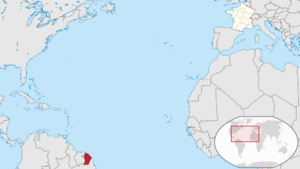 |
|||
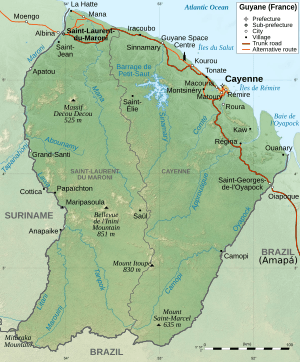 |
|||
| Country | |||
| Prefecture | Cayenne | ||
| Departments | 1 (every overseas region consists of a department in itself) | ||
| Area | |||
| • Total | 84,000 km2 (32,433 sq mi) | ||
| • Land | 83,534 km2 (32,253 sq mi) | ||
| • Water | 466 km2 (180 sq mi) | ||
| Area rank | 2nd region and 1st department | ||
| Population
(January 2024)
|
|||
| • Total | 295,385 | ||
| • Density | 3.516/km2 (9.10754/sq mi) | ||
| Demonym(s) | (French) Guianan (French) Guianese |
||
| GDP | |||
| • Total (2022) | €4.562 billion | ||
| • Per capita | €16,600 | ||
| Time zone | UTC-3:00 (GFT) | ||
| Area code(s) | +594 | ||
| ISO 3166 code |
|
||
| Currency | Euro (€) (EUR) | ||
| Website | Territorial Collectivity Prefecture |
||
|
Unofficial Flag of French Guiana
|
|||
French Guiana is a special part of France. It is located on the northern coast of South America. It's bordered by Suriname to the west and Brazil to the east and south.
French Guiana covers about 84,000 square kilometers. As of January 2024, around 295,385 people live there. It is the second-largest region in France. It is also the largest "outermost region" of the European Union.
This area has a very low population density. This means there are not many people living per square kilometer. About half of its people live in its capital city, Cayenne. Most of French Guiana (about 98.9%) is covered by thick rainforests. The Guiana Amazonian Park is the largest national park in the European Union. It covers 41% of French Guiana.
Since 2015, French Guiana has been governed by a single assembly. This assembly is called the French Guiana Assembly. It handles both regional and local government tasks. Its current president is Gabriel Serville.
French Guiana became a full part of the French Republic in 1946. It uses the euro as its money. A big part of its economy comes from the Guiana Space Centre. This is where the European Space Agency launches rockets. The official language is French. However, many other languages are spoken by different communities. French Guianese Creole is the most common local language. French Guiana is the only part of mainland Americas that is still controlled by a European country.
The border between French Guiana and Brazil is the longest land border France shares with another country.
Contents
What's in a Name?

The name "Guyana" means "land of many waters." This comes from an old local word. The "French" part was added during colonial times. Back then, there were five similar colonies along the coast. They were called "the Guianas." Each was controlled by a different European power. These included Spanish Guiana, British Guiana, Dutch Guiana, French Guiana, and Portuguese Guiana. Today, French Guiana, Guyana, and Suriname are still called "the Guianas." They are part of a large land area called the Guiana Shield.
A Look at History
French Guiana was first home to indigenous people like the Kalina and Lokono. The French tried to set up a colony here in the 1500s. But they didn't really stay until they founded Cayenne in 1643.
The colony grew by using enslaved people from Africa. They worked on large sugar farms. Slavery was ended in French Guiana in 1794.
Early attempts by France to settle Guiana in 1763 failed badly. Many settlers died from tropical diseases and the harsh climate.
Later, France used Guiana as a penal colony. This was a place where prisoners from France were sent for forced labor. This system lasted from 1852 to 1953. One famous prison was on Devil's Island. Many prisoners did not survive their sentences.
A border argument with Brazil happened in the late 1800s. It was about a large jungle area. The argument was settled by the Swiss government. Most of the land went to Brazil.
During World War II, French Guiana was part of Vichy France. But it joined Free France in 1943. In 1946, it stopped being a colony and became a French "department."
In the 1970s and 80s, France helped Hmong refugees from Laos move to French Guiana. They were escaping war in their home country. Later, many refugees from Suriname arrived, fleeing their own civil war. More recently, people from Brazil and Haiti have come seeking better lives.
In 1964, French president Charles de Gaulle decided to build a space launch site in French Guiana. This was meant to help the economy. It was a good spot because it's close to the equator. The Guiana Space Centre has grown a lot. It is now a key launch site for the European Space Agency. It has launched important rockets like the Ariane 5 and even the James Webb Space Telescope.
In 2017, workers in French Guiana went on strike. They wanted more resources and better infrastructure. This led to the biggest protest ever in French Guiana.
Exploring the Geography
French Guiana has two main areas. There's a coastal strip where most people live. Then there's a dense, hard-to-reach rainforest inland. This forest slowly rises to the Tumuk Humak Mountains near the Brazilian border. The highest point is Bellevue de l'Inini, which is 851 meters tall.
There are also small islands off the coast. These include the three Salvation's Islands, which have Devil's Island.
The Petit-Saut Dam creates a large artificial lake. This dam provides hydroelectricity for the region. Many rivers flow through French Guiana, like the Waki River.
A big part of the Amazonian forest in French Guiana is protected. It's called the Guiana Amazonian Park. It's one of France's ten national parks.
Weather and Climate
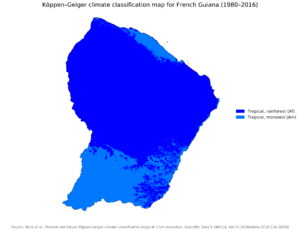
French Guiana has an equatorial climate. This means it's hot and very humid all year round. It gets a lot of rain, especially from December to July. During these months, over 330 millimeters of rain can fall each month.
From August to November, the eastern part has a warm dry season. Rainfall is lower, and temperatures can go above 30°C.
Nature and Environment
French Guiana has many different natural areas. These include rainforests, coastal mangroves, and savannahs. It has a very high level of biodiversity. This means there are many different kinds of plants and animals. Its old-growth forests are especially rich in species.
These forests are protected by the Guiana Amazonian Park and other nature reserves. Organizations like the IUCN and EU want special efforts to protect these areas.
About 5,500 plant species have been found here. This includes over a thousand types of trees. There are also 700 bird species, 177 mammal species, and over 500 fish species. Many of these fish are found nowhere else.
Threats to the environment include gold mining and illegal hunting. Roads also cause some habitat damage. But logging is not a huge problem because there are few roads. The beaches of the Amana Nature Reserve are important. They are a huge nesting site for leatherback turtles.
Farming and Soil
French Guiana has some of the poorest soils in the world. They don't have many nutrients. Farmers often use a method called slash and burn agriculture. This helps to make the soil better for growing crops.
Scientists are studying ancient soils found in French Guiana. These soils were made by people long ago and are very rich. They hope to learn how to create similar fertile soils today.
How the Economy Works
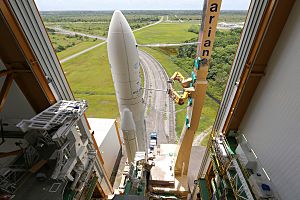
French Guiana is part of France. This means it is also part of the European Union and uses the euro.
In 2019, French Guiana's economy was worth about US$4.93 billion. It's the second-largest economy in "the Guianas."
From the 1960s to the 2000s, French Guiana's economy grew a lot. This was thanks to the Guiana Space Centre and a growing population. The economy didn't suffer much during the 2008 financial crisis.
However, since 2013, economic growth has slowed down. The space center is still very important. It makes up about 16% of French Guiana's economy.
French Guiana relies a lot on mainland France for money and goods. The main industries are fishing, gold mining, and timber. There is not much manufacturing. Farming is also not very developed. It mostly happens near the coast. Farmers grow fruits and vegetables for local use. Tourism, especially ecotourism, is becoming more popular.
Unemployment has been high for many years. It has been between 17% and 24%.
People and Population
French Guiana's population stayed about the same for a long time. This was because of its history as a penal colony and health problems like yellow fever.
But the population started to grow a lot from the 1950s. This was due to better health care and the building of the Guiana Space Centre. Many people moved there from mainland France and neighboring countries. The population grew very fast in the 1980s because of refugees from Suriname.
Today, the birth rate is still high. More people also arrive seeking safety. French Guiana's population reached 295,385 in 2024. This is more than 10 times what it was in 1954.
Main Cities and Towns
Most people in French Guiana live in three main areas:
- Cayenne: The capital city, with about 151,103 people in 2021.
- Saint-Laurent-du-Maroni: With about 50,250 people.
- Kourou: With about 27,442 people.
Other important towns include Mana, Apatou, and Maripasoula.
Different Groups of People
French Guiana has many different ethnic groups. Most people live along the coast. In 2019, about 56.5% of people were born in French Guiana. Others were born in mainland France or other French Caribbean islands. About 31.5% were born in other countries, mainly Suriname, Brazil, and Haiti.
People of African descent are the largest group. This includes Creoles and Haitians. People of European background make up about 14% of the population. Most of them are French.
There are also Asian communities, like Chinese and Hmong from Laos. Other groups include Indians, Lebanese, and Vietnamese.
In the interior, you'll find the Maroons. They are descendants of escaped African slaves. They live mostly along the Maroni River.
The main indigenous groups make up about 3-4% of the population. These include the Arawak, Carib, and Wayampi people.
Immigration to French Guiana
French Guiana has seen more immigrants in recent years. Many come from other South American, Caribbean, and Middle Eastern countries. They see French Guiana as a "gateway" to Europe because it is French territory.
Religion and Beliefs
The main religion in French Guiana is Roman Catholicism. Some Maroon and Amerindian groups follow their own traditional religions. Many Hmong people are also Catholic because of missionaries who helped them settle here.
Birth Rates
The birth rate in French Guiana is quite high. It is much higher than in mainland France. This high birth rate is a big reason why the population is growing so fast.
Languages Spoken
The official language of French Guiana is French. Most people speak it as their first or second language. But many other local languages are also spoken. These include French Guianese Creole, which is based on French.
There are also six Amerindian languages and four Maroon creole languages. Other languages you might hear are Portuguese, Mandarin Chinese, Haitian Creole, and Spanish.
How French Guiana is Governed
French Guiana is part of France. This means it is also part of the European Union. It is the largest land area of the EU outside of Europe.
The president of the French Republic is the head of state. The prime minister of France is the head of government. The French government handles things like defense and foreign relations.
The French president appoints a "prefect" to lead the local government. There is also an elected local assembly called the Assemblée de Guyane.
French Guiana sends two representatives to the French National Assembly. It also sends two senators to the French Senate.
A big challenge for French Guiana is people coming in illegally. This includes gold miners from Brazil and Suriname. The border with Suriname is hard to patrol because it goes through rainforest. The French government has launched operations to stop illegal gold mining. But the miners often return after these operations end.
Local Divisions
French Guiana is divided into 3 large areas called "arrondissements." These are then split into 22 smaller areas called "communes" (like towns or municipalities).
Getting Around: Transport
Transportation in French Guiana is mostly along the coast. It can be hard to reach places inland.
Roads
French Guiana has about 2,200 kilometers of roads. The main roads connect the coastal towns. For example, RN1 links Cayenne to Saint-Laurent-du-Maroni. RN2 goes from Cayenne to Saint-Georges-de-l'Oyapock. All major rivers now have bridges.
Many smaller roads are unpaved forest tracks. They are often closed to regular traffic. Some towns in the interior still don't have road access.
The Oyapock River Bridge connects French Guiana to Brazil. It opened in 2017. Now you can drive from Cayenne all the way to Macapá in Brazil.
No Trains
French Guiana does not have a railway system. There's a small train track at the space center for moving rocket parts. When it was a penal colony, prisoners built some small railway lines. But these are now unused and covered by the jungle.
Ports and Boats
Boat travel is common. The port of Dégrad-Des-Cannes handles most imported and exported goods. The port of Larivot is where fishing boats are based.
Rivers inland are used by canoes and small boats. They connect villages that can't be reached by road.
Airports
French Guiana has one main airport, Cayenne – Félix Eboué Airport. It's in Matoury. There are also several smaller airstrips.
You can fly directly from Cayenne to Paris. There are also flights to other Caribbean islands, Miami, and Brazil. A local airline offers flights to smaller towns within French Guiana.
Public Transport
Cayenne has a public bus service. For travel between coastal towns, people often use "collective cabs." These are minibuses that leave when they are full.
On the main rivers, there are "pirogue cabs." These are small boats that take people to inland villages or across the border.
Military and Security
French Armed Forces
About 2,000 French military personnel are stationed in French Guiana. They include:
- The 9th Marine Infantry Regiment in Cayenne.
- The 3rd Foreign Infantry Regiment in Kourou.
- The RSMAG Regiment in Saint-Jean-du-Maroni.
- Air transport squadrons with helicopters and planes.
- A French Navy group with patrol vessels.
- A fire brigade from Paris that protects the Guiana Space Centre.
Police Forces
The National Gendarmerie and the French National Police are also present. They have about 840 staff. They are spread across 16 "brigades" in different towns. The Maritime Gendarmerie operates patrol boats along the coast.
Culture and Life
Buildings and Design
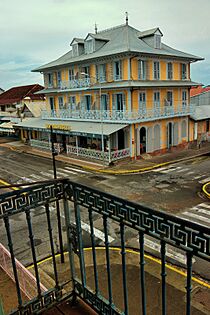
The buildings in French Guiana show influences from Creole, Amerindian, and Bushinenge cultures. Main towns have many Creole-style buildings. In areas where black Maroon people live, you can see Bushinenge-style houses. Amerindian communities have traditional "carbets." These buildings often use local materials like wood from the Amazon forests.
Festivals and Celebrations
The Carnival is a huge event in French Guiana. It's thought to be the longest in the world. It starts in early January and ends in February or March. Groups in costumes parade with decorated floats. They dance to the beat of drums and brass music.
Brazilian groups also join the parades with their lively rhythms and costumes. The Chinese community adds its own touch with dragons.
In the evenings, special characters called Touloulous go to masked balls.
Food and Cooking
French Guianan food is a mix of different cultures. You can find Creole and Chinese restaurants in cities like Cayenne. The local food blends Creole, Bushinengue, and Native American cooking styles.
Many dishes use Manioc and smoked meats and fish. Some typical dishes include Awara broth, Creole galette, and Pimentade (fish or chicken stew). Atipas are local fish often cooked with coconut milk.
At Easter, people traditionally eat Awara broth. For weddings, a type of curry called Colombo is popular.
Stories and Books
French Guiana literature includes works by local writers. They write in both French and French Guianese Creole. This literature often talks about slavery and other social issues. It also includes traditional tales, legends, and fables.
Writers like Alfred Parépou were important in the 1800s. In the 1900s, writers like Serge Patient and Elie Stephenson wrote about the experiences of black people. More recently, writers like Christiane Taubira have continued to explore these themes. Others write about the nature of the region.
Sports and Games
Sports in French Guiana have a long history. The first organized sports event was in 1890. It included foot races, canoe races, and bicycle races.
Today, the most popular sport is football (soccer). Basketball, cycling, swimming, and handball are also popular.
French Guiana is not a member of the Pan American Sports Organization. Its athletes compete under the French National Olympic and Sports Committee.
Since 1960, the Tour of Guiana has been held every year. It's a bicycle race with multiple stages.
Football (Soccer)
The French Guiana national football team is called Yana Dòkò. It's made up of the best local players. It is not part of FIFA, but it is a member of CONCACAF.
Their first match was in 1936 against Dutch Guiana (now Suriname). Their biggest win was 11 to 1 against St. Pierre and Miquelon in 2012.
Cycling Tour
The Tour of Guiana is a cycling race that happens every year. It links the main towns like Cayenne, Kourou, and Saint-Laurent-du-Maroni. It started in 1950 and has become very popular. Teams from many different countries now take part.
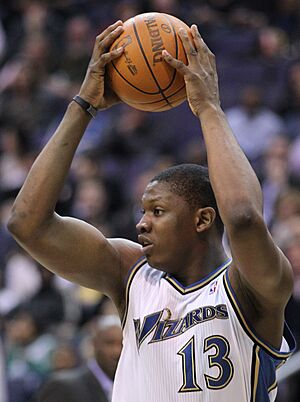
See also
 In Spanish: Guayana Francesa para niños
In Spanish: Guayana Francesa para niños
- Republic of Independent Guiana



